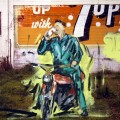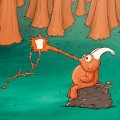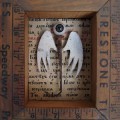The dickering over the proper term for artists who don’t fit neatly into the critical matrix sometimes obscures or prejudges unique creators. Whether they are “outsiders,” “naive artists,” “primitives,” mental patients or just plain ornery doesn’t really matter—the art that confronts the viewers is the only important thing. SJSU’s Thompson Gallery is currently displaying a generous selection of oil paintings by Jon Serl, a wholly self-taught artist on a major scale who came to his art relatively late in life and lived in semi-isolation in Lake Elsinore, Calif., until his death, at age 98, in 1993.
Serl’s oil paintings (mostly on board rather than canvas) often depict amorphous figures of both people and animals with free-flowing, almost liquefied outlines. The large Others Someplace Else (late 1980s) conjures up a lost world in which three ochre and yellow imaginary dinosaurs cavort in front of a mountain range beneath of swirling blue and white sky that would do a well-schooled Impressionist proud.
Some pieces pass into the realm of the nightmare. Between Two Worlds (1982) inflicts a plague of floating, crawling Boschean apparitions on a tortured figure in a blue smock lurching under the weight of his visions, his arms morphing into large curving claws.
At times, Serl seems to be illustrating a book of private fables or parables unknown to any library. Purple Cow (1989) offers a frieze of happy folk alongside the large titular beast. They celebrate the animal’s fecundity with the buoyant joy of Chagall characters. In Untitled (Bridge Crossing) (undated), a man in a long red coat advances with great confidence across a rickety wooden scaffolding, carrying a ladder and accompanied by assistants front and back. One of his lackeys holds an official banner aloft—indicating perhaps that this is a noble man headed for a fall of some kind. The scene is nicely complemented by a tiny figure below holding an umbrella and matching the “great man” stride for stride.
Serl’s assured technique shows to great effect in Chili Peppers (circa 1990). A tapestry covered with abstract shapes traced in white against a deep red background occupies the center. On the left, ecclesiastical figures all in red march in a line. To the right, three more figures kneel to pray—facing away from the viewer, their red bodies and mitres start to merge until they look like the chili peppers of the title. The composition is nicely balanced but not static; the colors are vivid and varied; and the transformation of holy men into earthy vegetables is visually witty. If Jon Serl was self-taught, he had a great teacher.
The exhibit is accompanied by an excellent catalog titled Jon Serl: The Mutability of Being, by Randall Morris, Cara Zimmerman and the Thompson Gallery’s director, Jo Farb Hernandez.
Jon Serl: The Mutability of Being
Runs through May 17
Natalie and James Thompson Gallery, Art Building, SJSU

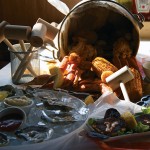 Blue Water Seafood & Crab Opens In Willow Glen
Blue Water Seafood & Crab Opens In Willow Glen 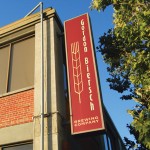 Gordon Biersch 25th Anniversary
Gordon Biersch 25th Anniversary 